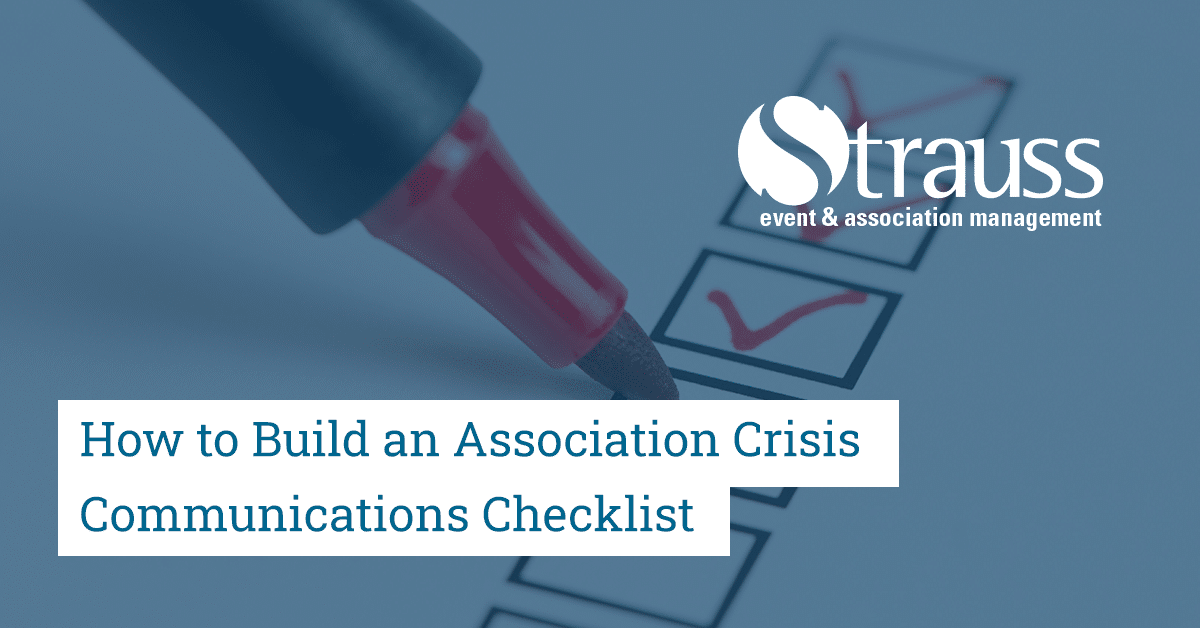Let’s face it; no association wants to go into crisis communications mode. But ultimately most will face an internal or external issue requiring immediate attention. How an association fares during and post-crisis depends on how well-prepared it is to handle one. The key to successfully navigating through a crisis is having a crisis communications checklist in-house prior to any potential issues.
Common issues that can force an association into crisis communications mode can range from a former member going rogue on social media, a misstep by a Board member, leaked internal-only association documents, or outside interference circulating misconceptions about the association and what it does.
Issues plaguing an association can start small but quickly snowball into a bigger issue if not immediately dealt with. When facing a crisis, a typical response is to go ‘radio silent’ thinking it’ll go away or be yesterday’s news. This rarely happens, and the longer an association waits to act, the worse it can get, and ultimately results in the wrong voice taking over the narrative.
Fear of making a misstep and making the situation worse can also cause associations to delay its response. But as noted above, it’s better to take control of the narrative than waiting for someone else too!
To help associations be prepared and to act quickly in the wake of a crisis, it’s vital to plan for the unexpected to help the association kick into action quickly if an unwanted crisis comes to fruition. When developing the crisis communications checklist, it is important to keep the four phases of crisis communications in mind including: Readiness, Response, Reassurance, and Recovery.
Below is an outline on how to effectively build a crisis communications checklist for an association. The checklist will help the association ensure it has key documents in place to better utilize its time and resources during this highly stressful time.
- Foresee the Unforeseeable – develop a crisis communications plan outlining possible threats and scenarios that could negatively impact the association including how to be ready and plan accordingly. Boilerplate responses are key to quickly deliver soundbites and ‘buy’ extra time to formulate more tailored responses to control the narrative and prevent the issue from spiraling. An example of a boilerplate response is, “We’re aware of the situation and working closely to resolve it. We’ll be in touch soon with additional information and next steps. Thank you for your patience.”
- One Voice vs. Multiple Voices – create a designated spokesperson list and circulate it to the Board and all members of the association. The list will highlight the role, title, and contact information of the designation spokesperson and confirm they are the only person allowed to respond on behalf of the association when in crisis. The list should also include the name and contact details of the association’s communications team for members to direct any internal or external inquiries.
- Know your Key Messages – despite the different types of issues an association can face, it’s still imperative to have a key message document to refer to when in a crisis that captures the key messages the association wants delivered including who the association is, its mission and values, etc. This document can be tailored but ideal to have in place and ready to go if needed.
- Internal Communications – develop an eblast template to quickly update, reassure, and inform members of said issue and the association’s response to help reduce speculation and misinformation from being shared among members. And note more information to come and highlight the communications team within the association should members have questions or are dealing with outside inquiries.
- Social Media Monitoring – have a designated staff member responsible for monitoring social media in the wake of a crisis to keep Board members and the communications team apprised of how quickly the issue is escalating on social media and what the temperature is among key audiences. The designated staff members should also craft boilerplate captions such as “We’re monitoring the situation and will keep all members informed in a timely fashion. Please ensure to direct any internal or external inquires to our communications team.” Or ‘thank you for your inquiry, our communications team will respond to your inquiry by end of day.” Monitoring social media and other communications tools used by the association will also help in the recovery of the association post-crisis to get it back on track and focused on its annual objectives and goals.
If a positive can come from a crisis – it’s the learnings. As part of the post-crisis recovery, it’s key to create a learnings document and amend the existing crisis communications plan to incorporate these learnings and strengthen it. Hopefully, the association will not face another issue, but it is best to be prepared.
Remember the above checklist and documents don’t age like a fine wine. Rather they become outdated if not maintained and updated on a regular basis. Appoint a staff member to be responsible for this task.
An association won’t know when a crisis will happen. But knows it will likely happen at some point and it can be prepared. So be prepared with a crisis communications checklist and supporting documents.
Read more about how to manage an association:
Tips on How to Effectively Tackle Your To-do List as an Association Leader in 2023
The Importance of Conflict of Interest Policies within an Association’s Board

